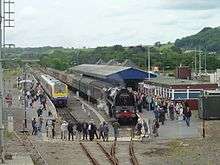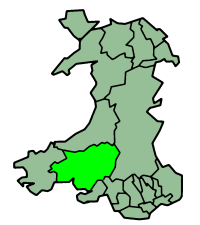Carmarthen railway station
Carmarthen railway station is on the edge of the town of Carmarthen, Wales, south of the River Towy. It is on the West Wales Line. The station and most of the passenger trains serving it are operated by Transport for Wales. Great Western Railway also run a limited service between Carmarthen and London Paddington, usually one train each way daily with additional services on Sunday.
| Carmarthen | |
|---|---|
| Welsh: Caerfyrddin | |
.jpg) | |
| Location | |
| Place | Carmarthen |
| Local authority | Carmarthenshire |
| Coordinates | 51.853°N 4.306°W |
| Grid reference | SN412196 |
| Operations | |
| Station code | CMN |
| Managed by | Transport for Wales |
| Number of platforms | 2 |
| DfT category | D |
| Live arrivals/departures, station information and onward connections from National Rail Enquiries | |
| Annual rail passenger usage* | |
| 2014/15 | |
| – Interchange | |
| 2015/16 | |
| – Interchange | |
| 2016/17 | |
| – Interchange | |
| 2017/18 | |
| – Interchange | |
| 2018/19 | |
| – Interchange | |
| History | |
| Key dates | Opened 1902 |
| National Rail – UK railway stations | |
| |
Facilities
.jpg)
The station is fully staffed, with the ticket office on platform 1 manned all week (Monday to Friday: 06:45 – 18:00, Saturday: 08:00 – 18:00, Sunday: 10:15 – 17:45). A self-service ticket machine is provided for use outside these times and for collecting pre-paid tickets. A buffet and newsagents shop ("The Coracle Buffet") is available here, along with toilets and a waiting room on platform 1; platform 2 has a shelter and bench seating. Train running information is provided by digital CIS displays, timetable posters and automated announcements. Step-free access is available to both platforms, though platform 2 requires the use of a foot crossing - wheelchair users are advised not to use this without assistance.[1]
Services
To the east, Transport for Wales operate regular services to Swansea, Cardiff Central, Crewe and Manchester Piccadilly. Great Western Railway currently operate one service per day (Mon-Sat, 3 on Sundays) between this station and London Paddington. The majority of local train services west of Carmarthen are timed to connect with the London Paddington services at either Swansea or Cardiff Central.[2]
To the west, Transport for Wales operate services to Pembroke Dock, Milford Haven and Fishguard Harbour. Carmarthen is the eastern terminus for a few of these services.[3]
The British Transport Police maintain a presence at Carmarthen.
Rail and sea corridor to Ireland
Some of Transport for Wales' boat trains to and from Fishguard Harbour serve the station. These connect with the Stena Line ferry to/from Rosslare Europort in Ireland with a daily morning and evening service in both directions. This route has been in existence since 1906.
| Preceding station | Following station | |||
|---|---|---|---|---|
| Ferryside | Transport for Wales West Wales line |
train reverses | ||
| Whitland | ||||
| Llanelli | Great Western Railway London - Carmarthen |
Terminus | ||
| Pembrey and Burry Port | Great Western Railway London - Pembroke |
train reverses | ||
| Whitland | ||||
History



South Wales Railway
The present station is the third to serve the town and dates from 1902,[4] although the South Wales Railway's main line from Swansea to Neyland reached Carmarthen some fifty years earlier. This original station had been built with westward expansion in mind and was situated at the base of the triangular junction, half a mile south of the present station and poorly sited for the town.
Carmarthen and Cardigan Railway
A second station (Carmarthen Town) was opened by the Carmarthen and Cardigan Railway in 1860[5] on its route northwards towards Cynwyl Elfed and Pencader which was much better sited for the town (on the opposite side of the river) and this remained in use until its replacement by the current station shortly after the turn of the century. The Town station did however remain in use for goods traffic thereafter beyond the closure of the final portion of the line Carmarthen and Cardigan Railway in September 1973, until the goods yard closed around 1981 - the single track girder bridge over the River Tywi was subsequently removed during 1983.
The Carmarthen and Cardigan Railway, in spite of its name, never actually reached Cardigan, as it was constructed only as far as Newcastle Emlyn (which was reached only in 1895). Cardigan was eventually served instead by the winding Whitland and Cardigan Branch Line from Whitland, the primary junction in Pembrokeshire. The C&CR did however link up with the ill-fated Manchester and Milford Railway at Pencader, putting the town on a through route to Aberystwyth by 1867.
Other railways
Another outlet to the north came courtesy of the Llanelly Railway's branch from Llandeilo, which reached Abergwili Junction in 1864 and whose trains reached the Town station by means of running powers following its takeover by the LNWR in 1873. The final link in the chain of lines to the north was added in 1911, when a branch line from Lampeter to Aberaeron was opened by the Lampeter, Aberayron and New Quay Light Railway. This was worked by the Great Western Railway from the outset, as the company had by this time absorbed the other lines mentioned (apart from the Llandeilo branch, which remained in LNWR hands until the 1923 Grouping).
Closures
Today, none of the lines to the north survive, the first round of closures having begun as early as May 1951 when the Aberaeron line lost its passenger trains. The Newcastle Emlyn line followed suit in September 1952, whilst the Llandeilo branch went in September 1963 and the 'main line' to Aberystwyth in February 1965,[6] although milk trains continued to operate as far as Pont Llanio (near Tregaron) on the Aberystwyth main line until 1970 and to Newcastle Emlyn and to Felinfach on the Aberaeron branch until September 1973. This left only the original South Wales Railway main line to serve the station and left it as a terminus at the end of short spur from the main line at which all trains have to reverse before continuing their journeys. This was not so much of a problem with DMUs but led to the need for a run-round of locomotive-hauled trains which were regularly used until the mid-1980s. Only two of the five original platforms here (the former platforms 2 & 3) are now used, with the majority of trains using the former down main platform (now numbered 1) where the main facilities are located. The other active platform (formerly platform 3, now renumbered 2) is used when two trains are scheduled to call at the same time (also for unit stabling) - it is linked to platform one by a barrow crossing that spans the shunting neck that is used for locos to run around their trains. This is the sole remnant of the former route north.[7]
Gwili Railway
Historically, the line to Aberystwyth and Llandeilo continued beyond the station across the River Towy past the site of the goods yard (now a builders yard) and then through a cutting (that has since been buried under the Carmarthen eastern by-pass dual carriageway) to as far as the former Abergwili Junction.
The Aberystwyth line then turned north out to Bronwydd Arms. From Abergwili Junction northwards, the railway trackbed resumes and is owned by the preserved Gwili Railway which runs preserved trains along part of the Aberystwyth line, through the valley of the River Gwili, from Abergwili Junction, through Bronwydd Arms and Llwyfan Cerrig, to as far as Danycoed en route, close to Cynwyl Elfed.
The Gwili Railway aims to restore a further 3 1⁄2 miles (6 km) of Track, again following the course of the River Gwili, past Cynwyl Elfed and further up the valley to Llanpumpsaint.
First World War Memorial
.jpg)
In June 2019, a plaque was unveiled at the station to commemorate the eight Great Western Railway workers from Carmarthen who lost their lives in the First World War. This was based on the work of a local train driver who researched the names. The unveiling ceremony was attended by over 100 people including local dignitaries and representatives from the Armed Forces.[8]
Notes
- Carmarthen station facilities National Rail Enquiries
- "Route 14 South and Central Wales and Borders" (PDF). Archived from the original (PDF) on 7 June 2011. Retrieved 22 December 2011.
- GB eNRT December 2018 Edition, Table 128
- Body, pp.54-55
- Page, p.130
- Page, p.195
- Passengers crossing the tracks at Carmarthen railway station Jaggery, Geograph.org; Retrieved 20132-11-13
- https://news.tfwrail.wales/news/remembering-the-fallen-carmarthen-train-drivers-campaign-to-honour-the-railwaymen-who-died-in-the-great-war
References
- Body, G. (1983), PSL Field Guides - Railways of the Western Region, Patrick Stephens Ltd, Wellingborough, ISBN 0-85059-546-0
- Page, J. (1988), Forgotten Railways: Volume 8 - South Wales (2nd Ed), David & Charles Publishers, Newton Abbott, ISBN 0-946537-44-5
External links
| Wikimedia Commons has media related to Carmarthen railway station. |
- Train times and station information for Carmarthen railway station from National Rail
